Three currency-like issues
La Violeta cigar factory
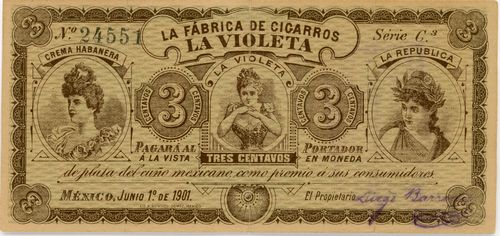
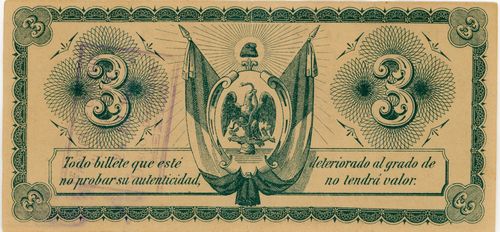 M698 3c La Violeta
M698 3c La Violeta
La Violeta cigar factory in Orizaba, Veracruz, owned by Maximilian Hirsch and later by the German Gustavo Mayer, began operating in 1898. This note, dated 1 June 1901, mentions three of its famous brands, La Violeta, Crema Habanera and La República, and offers three centavos in legal currency as a reward to purchasers. So not really paper currency.
The signature is of the owner of the store, Diego Barrena.
El Banco Nacional de Mazatlán
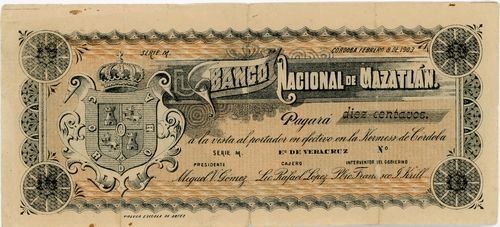
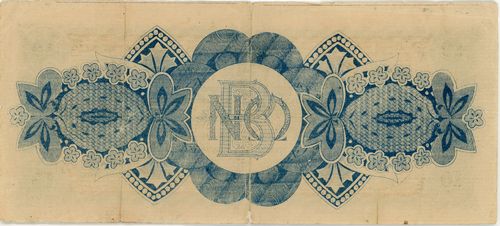 M768.5 10c Banco Nacional de Mazatlán
M768.5 10c Banco Nacional de Mazatlán
This Banco Nacional de Mazatlán note was issued in Córdoba, Veracruz in February 1903 as part of local festivities (Kermess) and promises to pay the bearer 10c in coin. The named officials (Miguel V. Gómez as Presidente, Rafael López as Cajero and Francisco J. Krill as Interventor) were all local dignitaries.
|
Miguel V. Gómez went on to become jefe politico of Orizaba, site of the Rio Blanco textile mills, where his readiness to kill is said to have provoked the admiration of the man who appointed him, President Porfirio Díaz. John Kenneth Turner, in Barbarous Mexico, wrote: “Regarding the powers of Miguel Gomez, I can hardly do better than to quote the words of an officer of the company, with whom De Lara and I took dinner one day: |
|
|
Rafael López Diéguez was a professor of Psychology, Logic and Ethics at the Provincial Institute of Secondary Education of Córdoba, and also a lawyer. At the beginning of the twentieth century his income was the largest in the city of Córdoba, thanks to the management with his brother, Francisco López Diéguez, of the casa López Lorenzo, wine cellar. He died on 13 October 1905. |
|
| Father Francisco J. Krill was a Catholic priest of American origin. He was priest of the church of the Virgin of the Immaculate Concepción (today Córdoba Cathedral) and is still remembered as a benefactor of the city, not only for his pastoral work, but also for his contribution to the community. He finished building the cathedral towers and decorating the cathedral, established the park benches, created the volunteer fire brigade, the Cuerpo de Bomberos del Comercio de Córdoba, which is still functioning and bears his name, and gave rise to the first Alameda, where he built a small artificial lake with boats and amusements for children. As an American, he introduced baseball to the city. |
El Banco del Centenario de Juárez
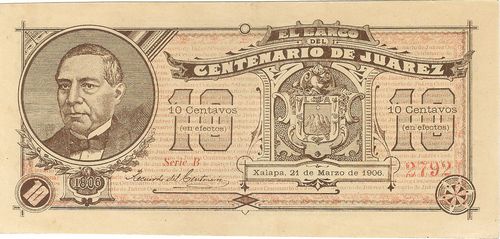
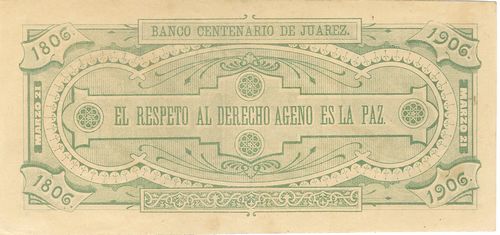 M769 10c Banco del Centenario de Juárez
M769 10c Banco del Centenario de Juárez
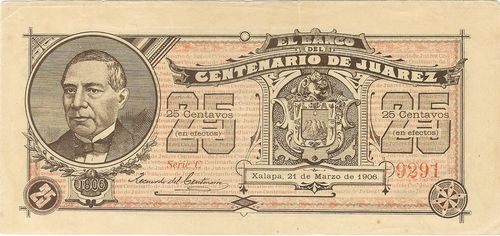 M770 25c Banco del Centenario de Juárez
M770 25c Banco del Centenario de Juárez
Not paper money, but included in Mexican Paper Money because they are of intrinsic interest and deliberately ape a banknote. These will have been produced by one of the commissions established to celebrate the centenary of Juárez’s birth (21 March 1806). They are dated 21 March 1906, the ‘signature’ is Recuerdo del Centenario (souvenir of the centenary) and the famous maxim on the reverse is taken from Juárez’s manifesto issued on 15 July 1867 shortly before his triumphal entry into Mexico City.
.Mexicanos: encaminemos ahora todos nuestros esfuerzos a obtener y a consolidar los beneficios de la paz. Bajo sus auspicios, será eficaz la protección de las leyes y de las autoridades para los derechos de todos los habitantes de la República. Que el pueblo y el gobierno respeten los derechos de todos. Entre los individuos, como entre las naciones, el respeto al derecho ajeno es la paz.
Confiemos en que todos los mexicanos, aleccionados por la prolongada y dolorosa experiencia de las comunidades de la guerra, cooperaremos en el bienestar y la prosperidad de la nación que sólo pueden conseguirse con un inviolable respeto a las leyes, y con la obediencia a las autoridades elegidas por el pueblo...
There was obviously also a 5c Series A, thus:
| series | from | to | total number |
total value |
||
| 5c | A | |||||
| 10c | B | includes numbers 2792 to 8557 | ||||
| 25c | C | includes number 9291 |
A similar issue was made in Querétaro.
Also listed here (until it can be correctly identified and placed) is a $500 note of a “Banco del Centenario", celebrating the centenary of the Grito de Dolores on 16 September 1810.

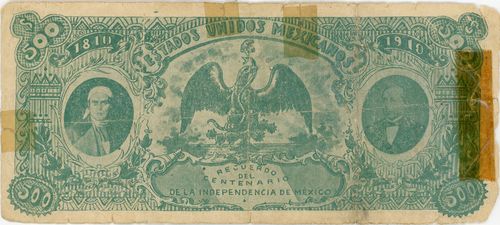 M unlisted $500 Banco del Centenario
M unlisted $500 Banco del Centenario
